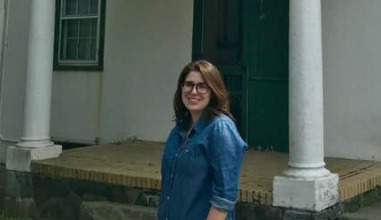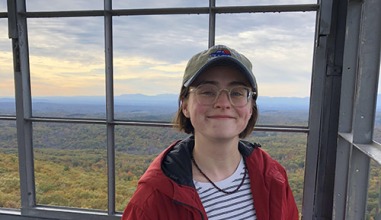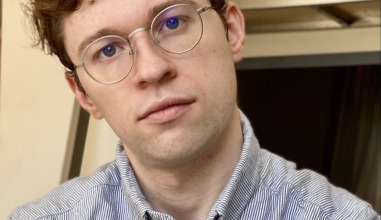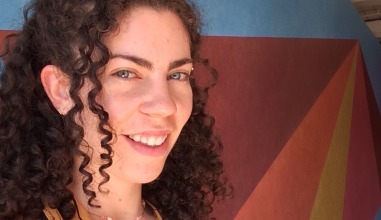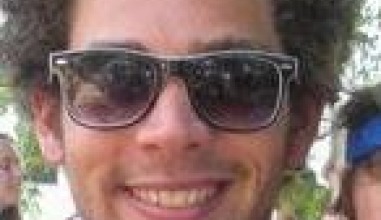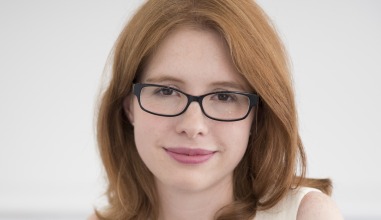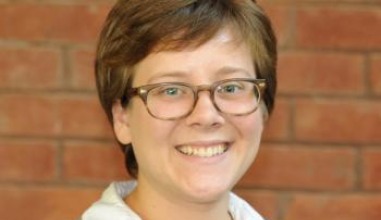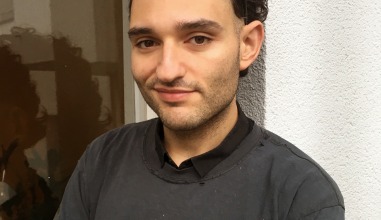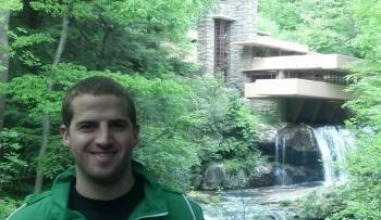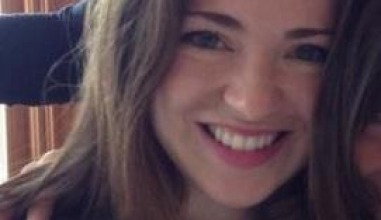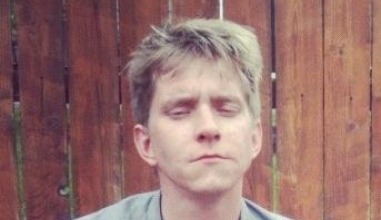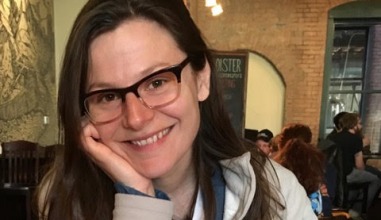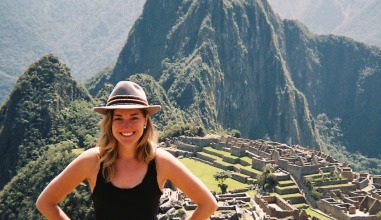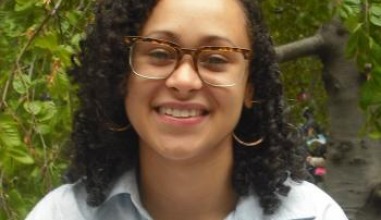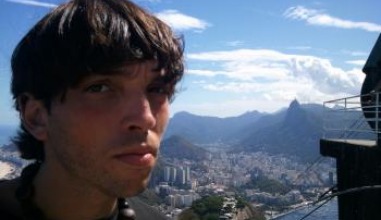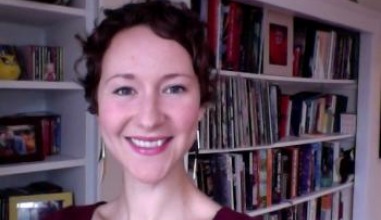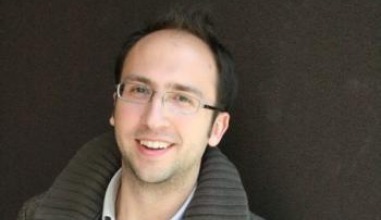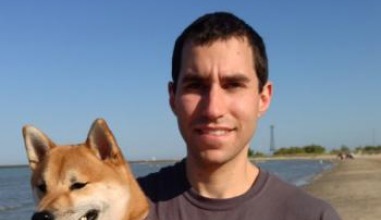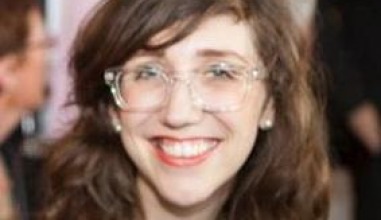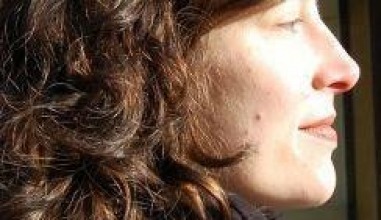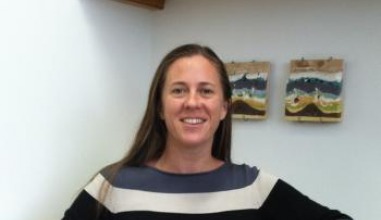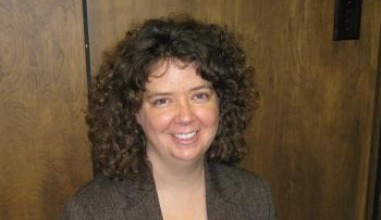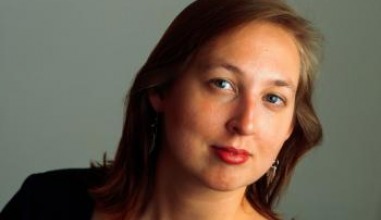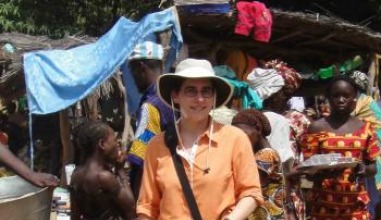We are very proud of our alumni! Our majors go on to work in architecture, arts management, community service, development, education, law, and museums and galleries — or physics, computer science, and economics. Those pursuing advanced degrees in art history have a brilliant track record. In recent years our alumni have been (or are) graduate students at the most prestigious academic institutions (UC Berkeley, Bryn Mawr, the Courtauld, Duke, Penn, Stanford, UCLA, Williams, and Yale, to name a few). Whether students choose to become specialists in art history or not, the art history major at Grinnell prepares them for a lifetime of deep engagement with culture and its significance both locally and globally. Here is what some of our alumni are doing today. If you are an alum, please keep in touch and send us your news! Thank you.
Vivien Makos ’19
(Art History) — During my time at Grinnell College, I was an assistant to the curator of the Print and Drawing Study Room — a job I held for two years. In this position, I handled, cataloged and managed prints, drawings, paintings, and other objects in the College’s collection. It was that job that nurtured my passion for working in museums, and maintaining art objects for the education of future patrons.
Now, as a 2019 alum, I find myself doing similar work with Delaware State Parks as their folk art collection intern. Specifically, I work with the Folk Art Collection at the State of Delaware’s Blue Ball Barn. The collection is small, but what it lacks for in size it makes up for with diversity as it contains impressive works by a variety of artists. However, this collection has not been touched, handled, or assessed since its inception. Years of fluctuating temperatures within the stone masonry structure, exposure to harsh sunlight from the untreated barn windows, and impacts from barn rental guests have definitely had an adverse effect on this collection.
The current collection manager and I are now working to assess the damage that has been done to these pieces, and how best to prevent it in the future. These challenges are extremely interesting as they usually require a bit more creative thinking than some of the problems faced by larger institutions. While larger museums undoubtedly face tough issues, I find that working at this small museum requires a consistent use of ingenuity that larger institutions have not required. I personally thrive in environments where the pressure is on to find attainable solutions to difficult problems. So, this opportunity has allowed me to both work with content I love, and also work in the environment I best perform in.
I am also responsible for cataloging all of the stored pieces, creating a rotation plan for the pieces on display and in storage, and researching new acquisitions for the collection. What’s more, I also work with the Alapocas Run education staff to create new programming at the Blue Ball Barn. We are committed to bringing in more diverse audiences — one that reflects the diversity of artists in the collection. I couldn’t be more excited to see where this job takes me, and I am always grateful that my experience at Grinnell College led me to it.
Lauren Toppeta ’17
(Art History) — I fell in love with the study of art history after my first 200-level class with Professor [Jenny] Anger. That class, Modern Art in Europe from 1900–1940, told me I wanted to be an art history major, and subsequently inspired me to pursue summer internships at the Leslie-Lohman Museum of Gay and Lesbian Art in New York City, and at Faulconer Gallery right in Grinnell. After graduating in 2017, I moved to my hometown of New York City to pursue a career working in the arts. I wasn’t sure exactly what kind of job I wanted, so I ended up interning at a gallery briefly before landing my favorite job to date, working on the team at SPRING/BREAK Art Show to organize and run the show during Armory Week 2018 (with a lot of babysitting in between). SPRING/BREAK was only a temporary job, and left me back on the search sooner than I would have liked. After striking out after many first-round interviews, I began to form a more concrete idea of the kind of work I want to pursue: art archives. Now, after working for a little under a year at a private school in Manhattan as part of their two-person communications team to be able to afford a life in New York, I will head off to obtain a dual degree in art history and library science in the fall of 2020 at Pratt Institute! My time as an art history student at Grinnell strengthened my writing abilities across countless categories, and has given me the skills to apply a critical eye to all that I encounter, professionally and personally. I am certain that without the growth the art history department fostered in me, I would not be on exactly the track I want to be, living in New York City, awaiting the start of my graduate career.
James Marlow ’16
(Art History and History) — Becoming an art history major was one of the best decisions I made as a student at Grinnell. The discipline’s rigorous mix of visual analysis, critical theory, and historical contextualization not only fostered a lifelong appreciation for the visual arts, but has also helped me develop research and critical thinking skills that have proven to be invaluable professionally.
A major highlight of my time at Grinnell was taking the travel course, “Berlin: Borders and Transgressions,” with my advisor, Professor Anger, and Professor Dan Reynolds in German. Examining the tangled history of Berlin through its built environment, this course sparked an interest in urbanism and architectural history that continues to guide my professional aspirations to this day.
Over my summer breaks, I was able to pursue internships at the New Museum of Contemporary Art and the New-York Historical Society, as well as a summer research assistantship with Professor Anger.
Since graduating in 2016, I returned to my hometown of New York City and have continued to apply art history professionally. In 2017, I began working in the publishing field at ITHAKA, the parent organization of JSTOR and Artstor research platforms. In my current role as a Paralegal, I regularly work with issues relating to art rights, image licensing, and copyright clearance across the organization.
I am so grateful for the ways in which the Grinnell Art History department served as a catalyst for my academic and professional growth. I have no doubt that without the department’s support and resources, I wouldn’t be where I am today!
Eliza Woods Harrison ’16
I came to Grinnell uncertain of where my many interests would lead me. Everything became clearer after my first art history class, when I realized that there was a field of study that embraced the interdisciplinary approach to learning and looking that I craved. My work as Professor Anger’s research assistant cemented my interest in twentieth-century art and revealed the unique discoveries that sustained scholarship can yield. One highlight was a MAP on the Erster Deutscher Herbstsalon, a huge but forgotten modern art exhibition hosted by the Der Sturm gallery in 1913. Together, Professor Anger, James Marlow ’16, Rebekah Rennick ’17, and I researched the show and collaborated with a team at the University of Iowa to create an interactive digital reconstruction of the exhibition space in which students could curate the myriad featured artworks. The project incited my passion for curatorial work and proved critical to my senior thesis “Early Sonia Delaunay: The Avant-Garde at Home” (advised by Professor Anger and recipient of the 2016 Phi Beta Kappa Scholar’s Award).
After graduating, I held internships and positions at arts organizations and museums, including MoMA, the Peggy Guggenheim Collection in Venice, and the Bogliasco Foundation. Still itching with questions raised by my studies and new questions about access in the arts raised by my work experiences, I’ve returned to school at the Williams Graduate Program. Nothing could have better prepared me for the combination of graduate coursework, curatorial work, and independent research than my time in Grinnell’s art history department.
Ian McCallum-Cook ’12
(Art History and Physics) — Art has been a lifelong passion of mine. It was the impetus behind my decision to study abroad in the Netherlands, where I spent five months of my junior year investigating studio and modern art. It has also proved a valuable counterpoint to my studies in physics, as I have always found it to foster creativity and an aesthetic awareness often lacking in the sciences. At Grinnell, I learned to appreciate this complementary relationship as I pursued a double major in physics and art history. After Grinnell, I continue to find considerable value in my art history background. Recently I was interviewed by a number of tech companies for internship positions, and I was surprised at how many asked about my art history experiences. A representative from IBM told me that my degree was one of the main reasons that I was asked to interview, as their company wanted well rounded and creatively minded employees. Apparently, I stood out favorably from the crowd; they have since offered me a job, which complements my graduate program in applied physics beautifully.
Rebecca Park ’10
(Art History and French) — The culmination of my art history study at Grinnell has to be the “Repeat, Reveal, React: Identities in Flux” Exhibition Seminar led by Professor Jenny Anger in fall 2009, which included the opportunity to assist with the editing and design of the accompanying catalogue. The department was also extremely helpful in providing support for interdisciplinary study, providing opportunities to combine my interests in both French literature and art. My study abroad program (Hamilton College Junior Year in France, 2008–09) in Paris featured coursework at the École du Louvre, and the art history faculty, especially Professor Susan Strauber, provided valuable research assistance for my MAP (“La Femme au travail chez Zola et chez Manet”), although it was done under the auspices of the French department (with Professor Philippe Moisan). My career opportunities following graduation were varied and included interning in the Publications Department at the National Museum of Women in the Arts in Washington, D.C.; working in public relations for an architecture firm (AWP) in Paris; and working as a research assistant for Professor Anger. I eventually relocated permanently to France, and in 2014, I joined the Terra Foundation for American Art at their Paris office, where I currently work as Program Associate, Publications & Communications.
Amanda Underwood ’10
(English and Gender, Women’s, and Sexuality Studies) — My experience in art history at Grinnell helped me discover how to translate my skills and interests into a career. I was an English major and originally started taking art history classes to flesh out my knowledge of aesthetics, critical theory, and artistic movements. In the fall of 2009, I participated in Jenny Anger’s exhibition seminar and loved collaborating with a small group of students to curate, design, promote, and write about works from the Grinnell College permanent collection. It was probably the most challenging thing I did at Grinnell, and it showed me that Grinnellians really thrive at the intersections of different fields of knowledge. After learning more about museum careers through internships at the Minnesota Children’s Museum, the Smith College Museum of Art, and the Minneapolis Institute of Arts, I now work for the University of Minnesota College of Design in Development and Alumni Relations. I am in the business of building relationships around people’s passion for art and design; how cool is that? The ability to critically analyze creative work and the drive to question dominant interpretations guide my work every day. I am also an master’s candidate in the strategic communications program at the University of Minnesota.
José B. Segebre ’09
Although I grew up in San Pedro Sula, coming to Grinnell felt oddly natural — from one middle-of-nowhere to another. I came to study literature, but promised my family economics, and instead took David Harrison’s advice to try art history. I became so fascinated by images, their power and language that I majored in art history. Susan Strauber became my advisor and supporter, while Jenny Anger and Dan Reynolds's seminar on Berlin introduced me to my current home city. Grinnell wasn’t easy, but the people I met there helped me: come-out, desire, achieve intellectual (and financial) independence.
Graduating amid a recession and coup in Honduras, I moved to my grandparents' in Monterrey, later relocating to México City. I worked for an American foundation and kept corresponding with Lesley Wright, who encouraged me to further pursue art.
In 2012 I moved to Frankfurt. Here I learned German, worked as assistant curator (Portikus, 2014) and completed an M.A. in Curatorial Studies (Goethe Universität, Städelschule, 2018). I wrote on film and contemporary art, and produced exhibitions with artist Anne Imhof, including the German Pavilion at the 2017 Biennale di Venezia (Golden Lion).
I now curate a series of performative and installative screenings with artist François Pisapia (Full Moon Screenings, 2019-). I am writing my Ph.D. in Philosophy/Aesthetics at the Hochschule für Gestaltung Offenbach on waiting, analyzing the temporality of power in contemporary art. My time at Grinnell informs my belief in art to transform reality and my responsibility therein.
William Schwaller ’09
(Art History) — I came to Grinnell wanting to be an architect and chose art history to prepare me for a graduate program in that field. I did not think that I would later pursue a graduate degree in art history or wish to work in the museum or academic fields. But every step of the way, Grinnell gave me amazing opportunities to explore my interests and develop as a person and a scholar. Thanks to the support of former President Osgood, I interned at the world-class firm, Pelli Clarke Pelli Architects. When I realized that architecture was not quite for me, Lesley Wright of the Faulconer Gallery turned on my interest in museums and helped me secure several museum internships. During my senior year, I interned at the Cedar Rapids Museum of Art. After graduating, I moved nomadically from the Philadelphia Museum of Art to MASS MoCA to the Minneapolis Institute of Arts before I settled down with a two-year fellowship at the University Art Galleries at Bucknell University. All of this is to say that Grinnell’s liberal arts education doesn’t just prepare you to go out into the world as a well-rounded and well-educated individual, but that it continues to motivate you to pursue your interests with the skills to succeed. Now in the art history doctorate program at Temple University, I am studying American and Latin American art since 1960.
Dayna Hamann ’09
(Art History) — Some might think that my choice to go into teaching and then social work is unrelated to my art history education at Grinnell but, luckily, I know otherwise. My days spent in the cozy hub of Bucksbaum’s second floor have influenced me and my path in both simple and profound ways. It was in my art history classes that I learned to pay attention, to find the beauty in everything, to always inquire about historical context and to question, question, question the author (or artist, as the case may be). I have used these skills of attentiveness, optimism and critical thinking every single day in my work in education, counseling and social justice. After I realized in my junior year that almost every art history paper I had written thus far had addressed gender and oppression, I began to have an inkling about where I was headed once I left Iowa. With the guidance of my professors and fellow students, I was able to begin shaping my worldview.
Chris Farstad ’09
(Art History) — Art history to me was a way to access and process as much information as possible without having to produce a body of art work in addition. I was interested in music and sound as mediums, and I felt that visual disciplines didn’t have the particular focus I was looking for. Art history was a way for me to deal directly with powerful methods of thought and records of doing in order to better refine my own investigative angle and voice. I now am part of the music group Food Pyramid and am currently participating in the release of our seventh record in three years. I am grateful to be part of a group of like-minded individuals, which, I can affirm, is where all great things begin. I would encourage current art history students to explore this power of collaboration for themselves and break down disciplinary barriers as much as possible. Thinking and writing about art and culture at Grinnell and beyond has exposed me to vastly different styles, cultures, and perspectives as well as avenues of thought, being, emptiness, and excess both past and present. I have found that doing and reflecting on art are part of one continuous, unending process of realization. I would never have understood this process so thoroughly had I not washed up on the beach of art history and left the raft at the shoreline.
Liza Newman ’08
(Art History) — I declared my major in art history with a sense of adventure, and my studies have certainly delivered on that front. I went abroad to Florence my junior year, studying Renaissance art and literature with Professor Mease. As a senior, my interest in avant-gardes and performance art led me to take modern dance classes and eventually to my MAP with Professor Anger on Ardengo Soffici, a Futurist artist and art critic. I was not sure whether I wanted to go to grad school, so I spent the year after graduation teaching English in France. In 2011, I got my master’s in art history from the University in Pennsylvania, with a thesis on Picasso’s illustrations for Balzac’s “The Unknown Masterpiece.” My formal training in art history ended there, but the critical thinking and writing skills I developed at Grinnell are foundational to my current work in law. My Grinnell education, particularly the writing intensive courses offered by Professor Anger and Professor M. Cummins, more than prepared me for the rigors of law school. I am now an attorney in my hometown of Cincinnati, where I represent plaintiffs alleging employment discrimination on the basis of race, age, disability, gender, and other protected classes. Just like in college, my days are (happily!) filled with research and writing. It is an honor to work within Grinnell’s tradition of social justice as an advocate for working people.
Julia McHugh ’07
(Art History) — Julia K. McHugh is the Trent A. Carmichael Curator of Academic Initiatives at the Nasher Museum of Art at Duke University. In this position, she develops exhibitions and interdisciplinary collaborations with Duke faculty, students, and staff at the Nasher Museum of Art. She also serves as adjunct assistant professor of art history and directs the Museum Theory and Practice concentration. McHugh specializes in ancient and colonial Latin American art and earned her Ph.D. in art history from the University of California, Los Angeles. Prior to the Nasher, she was the Douglass Foundation Fellow in American Art at The Metropolitan Museum of Art and a research assistant at the Getty Research Institute, where she assisted with the production of Golden Kingdoms: Luxury and Legacy in the Ancient Americas, a major exhibition of Pre-Columbian art. She has also held positions in the curatorial and education departments of the Los Angeles County Museum of Art and the Fine Arts Museums of San Francisco. She received a Fulbright-Hays grant to do research in Lima and Cusco, Peru, and has twice received Foreign Language and Area Studies Fellowships to pursue the study of the Quechua language.
Nicole (Niki) Reiner ’07
(Art History) — Greetings from New York! I am grateful to Susan Strauber for encouraging me in my decision to major in art history at Grinnell, which in turn influenced my whole academic and professional trajectory. After graduation, I returned to my home city of New York and completed several unpaid internships in art museums, one of which led to a full-time position as assistant manager of visitor services at PS1 Contemporary Art Center. After a couple of years, I returned to school and completed an master’s in museum studies at NYU, with a focus on the history and theory of museums. This August, I presented my thesis research on the emergence of ethnically-specific museums at the Smithsonian at the Fifth International Conference on the Inclusive Museum in Barbados, where I was honored with a Graduate Scholar Award for my paper entitled, “Melting Pot on the Mall? Race, Identity, and the National Museum Complex.” Presently, I work as a prospect researcher for development at the Museum of Modern Art, marking a return to my fine art roots. This March, I will marry the love of my life, Jonathan Patkowski ’09, whom I met in Tim Chasson’s Exhibition Seminar on Piranesi. Suffice to say, my time in the art history department at Grinnell was formative, and I look forward to returning for a long awaited visit in May.
Fredo Rivera ’06
(Art History and Africana Studies) —Fredo Rivera returned to Grinnell College in 2016, and is currently Assistant Professor of Art History. After graduating from Grinnell in 2006, Fredo attended Duke University, where they received a Ph.D. in Art History in 2015. During their time at Duke, Fredo conducted research on art, architecture and urban visual media in 1960s Havana, Cuba, and began research and curatorial projects regarding Haitian art and visual culture. In 2011-2013, they were an Andrew W. Mellon Predoctoral Fellow at the Center for Advanced Study in the Visual Arts (CASVA) at the National Gallery in Washington D.C. Since landing back in Grinnell, Fredo has continued their research on the Greater Caribbean both through exhibitions and publications. Recently they have developed new research on urban art, queer performance and urbanism in contemporary Miami. Fredo is also the Project Leader for the Haitian Art: a Digital Crossroads, a collaboration between Grinnell College Libraries and the Waterloo Center for the Arts to plan a digital database and consider the broader field of Haitian art history. Fredo is happy to meet alum passing through Grinnell (in a post-COVID future) — contact information is available in their faculty profile on our webpage.
Katherine Rochester ’06
(Art History and French) — If going to the middle of Iowa to pursue a curatorial career might have been a gamble, it surely never felt like one. Grinnell’s intimate size and setting meant that I could instantly connect not only with professors who would shape my intellectual life, but also with museum professionals working at Faulconer Gallery. The ability to both study and play a significant role in exhibition-making while at Grinnell proved essential when I later landed positions at the Walker Art Center and The Soap Factory in Minneapolis. By the time I graduated, I had been a curatorial assistant on a major William Kentridge exhibition, conducted archival research with Professor Jenny Anger through a mentored advanced project, and co-authored a catalogue essay for Professor Strauber’s Exhibition Seminar on Goya’s Disasters of War. In my current work as a doctoral candidate at Bryn Mawr College, a curator, and an art critic, I constantly cross paths with my fellow Grinnellians. Whether they’re working in galleries in Chelsea, making art in Bushwick, or working on their dissertations in Paris, Grinnellians working in the arts are everywhere — and they’re always in just the right places.
Patrick Waldo ’06
(Art History) — I knew I wanted to study art history when I arrived at Grinnell. I remember going on a tour with Alice Anderson ’04 as a prospective student and being deeply impressed by the College’s collection, the Exhibition Seminar, the Faulconer Gallery, and the ability to pursue mentored advanced projects (MAPs) or a thesis. I recognized and appreciated the fact that art history was challenging not because we had to memorize facts, such as artists, genres, and dates, but because of the rigorous analysis, both theoretical and historical. Honestly, I cannot imagine my life without the wonderful experiences of studying art history at Grinnell. I did an internship in Prague at the National Gallery’s Sternberg Palace. The next summer I returned with a stipend for my MAP on Alfons Mucha and Czech identity. I studied abroad in Florence and wrote my honors thesis on Arte Povera with Jenny Anger. After college, I lived in Italy for five years and took up a telecommuting job in programming and enterprise system building. Without formal training in IT, art history distinguished me in my job because I could think critically, visually, and innovatively. I have three patents pending out of that work. Finally, I combined my experiences in management and the arts through a double master’s program between Carnegie Mellon University (arts management) and the University of Bologna (innovation and organization of culture and the arts). Art history enriched my life personally and professionally, and I look forward to building my career from it.
Mordecai Scheckter ’03
(Art History) — I work at an architecture firm in Chicago, and am happy to say that I find myself in the midst of a challenging and thought-provoking career. Architects are often described as generalists — practitioners with wide-ranging bodies of knowledge, who apply ideas from diverse fields to their work. I think this is mostly true, as there are innumerable pragmatic and social elements that determine how successful the buildings and spaces we design are. But it’s important to emphasize not just what you know, but how you observe and analyze a problem when you approach it, and then how you discuss, communicate, and arrive at your solution. It was while majoring in art history that I learned these critical skills, and I found that Grinnell’s small, discussion-based classes encouraged exactly this sort of development. I’ve attributed this skill set to my experience at Grinnell, but my interest in the subject matter itself, architecture, also originates in the art history classroom. I enjoyed visiting museums growing up, which made me want to take art history courses. In those courses, especially regarding the development of modernism and its later critiques, I was introduced to a number of architectural examples and ideas that illustrated these concepts. This roused my interest, and I learned in graduate school that, thankfully, the technical and practical aspects of the field were as exciting to me as the theoretical. Now I find myself applying skills I learned at Grinnell towards a subject I discovered I loved there...not bad.
Carrie Robbins ’02
(Art History) — Was it the whirr of the projector or the drawn blinds in the classroom on a sunny day that guided my art history major? No, it was looking at pictures and letting them look back at me. It was guessing, through research and comparison at what these images might mean, knowing that my guesses wouldn’t be “right,” but that they might be suggestive or illuminating. I’ve been looking and guessing ever since. At Grinnell, I received professional training for work in the arts through a summer internship and week-long externship at a New York City gallery and art fair, through work in the Print and Drawing Study Room, and through curatorial participation in an Exhibition Seminar. These experiences helped me get hired in the Minneapolis arts scene, right out of school at the Walker Art Center, and then at Northern Clay Center as its exhibitions manager. But more than this, my art history major taught me to look carefully, to think critically, to consider things from multiple points of view, to disagree artfully with my peers, and to choose language carefully. Art history at Grinnell gave me the skills for a lifetime of learning, and beyond this prepared me for my eventual return to graduate school in the subject. Now in my final year of the doctoral program in history of art at Bryn Mawr College, I may not know what the discipline has in store for me next year, but I do know that I’ll keep looking at pictures and guessing about what they mean.
Jennifer Stob ’00
(Art History and French) — My engagement with art history began in the form of a second major at Grinnell. Art history and visual culture more generally grew into a vital interest, which then became the focus of my professional life. The Exhibition Seminar I took with Jenny Anger during my senior year was certainly a major influence: I loved debating photographic theory, exhibition theory, and the historical contexts of the Edward S. Curtis prints we were working on. I entered Yale University’s graduate program in art history in 2003 to continue studying aesthetic theory and indexical media. I now teach and write at the intersection of art and film history. In my teaching and writing, I always have in mind artist Jeff Wall’s aphorism, reversed: “art isn’t for everyone, but it is for anyone.”
Elizabeth Perrill ’99
(Art History) — As an art history major at Grinnell, I was finishing up my degree just as the Falconer gallery and expanded Bucksbaum Center was being completed. I had the opportunity to take an African art class with visiting lecturer, Victoria Rovine (also a Grinnell grad) just before I left for a study abroad in Zimbabwe. As part of the class we produced a catalog entitled “In a New Light: African Art at Grinnell College.” The combination of that classroom experience and my study abroad cemented my interest in African art history.
When I returned from Zimbabwe, I worked with Kay Wilson and Milton Severe as a work study student, installing and cataloging art in the Print Study Collection. I thought I wanted to go into museum work, so I applied to 12 internships and only received one — at the Metropolitan Museum of Art as a paid curatorial intern in the Department of Africa, the South Pacific, and the Americas! I was so excited. It was amazing and I was the only intern in the department. While interns the more well-funded and popular fields of Renaissance and Medieval art filed paperwork all summer, I wrote text, worked with exhibition designers on maps and color selections, chose artwork positions, and even helped mount textiles for an exhibition. But, I didn’t have a post-Met plan. Everyone runs into a few bumps in their path.
Thankfully, the Faulconer Gallery was just opening and needed someone to help with the development of art storage and as a gallery assistant. So for two years I returned to Grinnell. I then applied for graduate schools and selected Indiana University from about eight funding offers. After a straight shot through a master’s and doctorate funded by Fulbright-Hays, the SSRC, and others, I landed a tenure-track position just as the economic downturn hit. I started at UNCG, where I am now, in August 2008. So, luck was on my side there.
In the past 9 years, I’ve really enjoyed teaching at an institution that is now federally designated as a Minority Serving Institution. My classrooms are not areas of white privilege or entitlement in the ways I hear about from peers. I gained tenure in 2014 and am currently an Associate Professor at UNCG; it’s exactly where I want to be. Other opportunities have also developed that keep me engaged in scholarly learning. Starting in 2012, I was also given the opportunity to serve as the Consulting Curator for African Art at the North Carolina Museum of Art (NCMA) in Raleigh, about an hour’s drive away. The NCMA team and I just finished the grand reinstallation of the permanent galleries of African art in June! You can see all sorts of videos, blogs, etc.
The curatorial work I’ve been doing has definitely informed my teaching. Additionally, I’m currently one of nine people on the Advanced Placement Development Board for Art History. This is the board that develops AP Exams in art history, vetting content and questions for the 25,000+ students who take this exam each year. It’s very intense, but I love being the voice at the table that is constantly advocating for sophisticated questions on African and South Pacific content.
Every one of these roles draws upon my time at Grinnell. I actually just applied for an Excellence in Teaching Award at UNCG and mentioned my grounding in the liberal arts tradition. Fingers crossed on the award, which I submitted 18 minutes before the deadline. Hitting send reminded me of running across campus to Jenny Anger’s office to getting papers in just before the deadline. Thankfully, we don’t have to run to submit papers and applications anymore, but old habits of all kinds die hard.
Amy Miller ’93
(Art History) — I took art history as a freshman on a lark, and utterly fell in love with the realization that I was absorbing history, sociology, religious studies, gender studies, and more, all while looking at pretty pictures. Professor Timothy Chasson was my first instructor, and I became an art history major without a second thought. By my junior year and following a stint of studying abroad at Grinnell in London, though, I realized I didn’t have the chops to go on to graduate school in art. I chose law school instead, and now I’m a nonprofit civil rights lawyer for ACLU Nebraska. This is a Grinnellian’s dream: I wear jeans most days, I represent people whose fundamental constitutional rights have been violated but I don’t have to charge for my services, and I do a fair amount of public education in high schools. The art history degree now is the underpinning to my intellectual curiosity in the world around me rather than my profession, and I have no regrets.
Normandy Madden ’91
(Art History and Political Science) — Art was a major source of media during the last few thousand years, before TV, magazines, and the internet came along. It was used to communicate political aspirations, military conquests, the plight of the weak and poor, gender relationships. In addition, art produced in each historical period was a mirror into what was happening politically and socially during that time, both on the canvas, literally, and off. Looking at art through the ages can also be seen as an investigation of our world’s political history, and that was the point of my studies. I did not directly pursue art history after graduation. Instead, I pursued a career in journalism. I started out as an art/culture writer and gradually moved into business writing, but I quickly found a niche in covering advertising and marketing. If you squint closely enough, every now and then, an ad or campaign comes along that would qualify as art, at least for me. I spent five years in Prague working for newspapers like the Prague Business Journal, and today I am the senior vice president, content development, Asia-Pacific, for the Thoughtful Media Group ).
Victoria Rovine ’86
(Art History) — I became an art history major somewhere in the middle of my four years at Grinnell, after trying out a couple of other majors — I think I was a French major for a time, and perhaps a history major as well (it’s all a blur now!). But when I took an art history course for the first time, I knew I’d found my calling. I think it was a medieval art course with Chasson. I loved the art, which was all very new to me, but more than that I found that this was a field that could combine history, anthropology, literature, and all the other disciplines that interested me. To understand works of art, all of these fields were relevant. And the more art history courses I took, the more I fell in love with art from just about every place and era I studied. I went on to a career in museums (the Field Museum, the Brooklyn Museum, and the University of Iowa Museum of Art) and now a teaching position at the University of Florida, where I am an Associate Professor with a joint appointment in Art History and the Center for African Studies. I became an Africanist art historian, though I never studied Africa at Grinnell. But Grinnell led me to my passion for the study of art, so being an art history major was certainly a formative experience for me.

